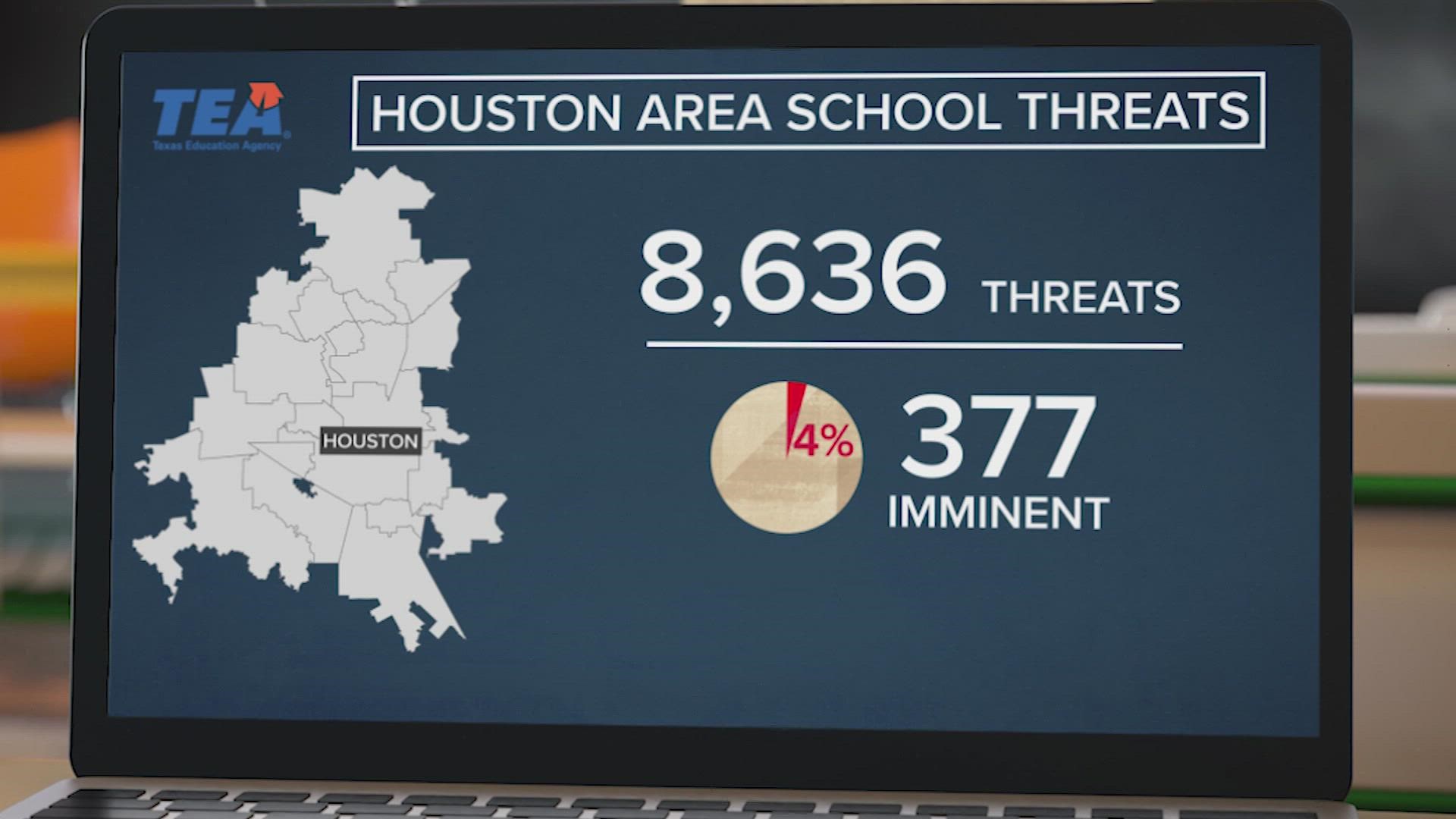HOUSTON — Texas schools are required to have Safe and Supportive School Program teams and also train members on how to assess and address threats to determine which ones are legitimate and whether to handle them internally or get law enforcement involved.
All school districts in Greater Houston have those teams and last school year, they reviewed more than 8,000 threat reports, a KHOU 11 Investigates analysis of Texas Education Agency data has found.
KHOU 11 Investigates looked at the teams tasked with making the determination and deciding whether the reported threat would be handled internally or referred to law enforcement.
All schools in Greater Houston have safety teams and train them to determine what is a threat and what is not. KHOU 11 Investigates looked at thousands of threats recorded by each district. Some districts had significantly more than others. Clear Creek ISD had the most in the area. They, and other districts with many threats, said that’s a good thing – it shows students are speaking up.
Here's a map of where the threats were assessed:
Clear Creek safety
An active Safe and Supportive Schools Program Team helped the district beef up its security this school year.
“It’s on the front of my mind every day,” Clear Creek High School Principal Ashley Orr said. “This is our main entry into the building. We are walking through a hallway that is immediately off the secure doors.”
A bullet-resistant vestibule provides a barrier between the Wildcats and the outside world. Additional school liaison officers from the Galveston County Sheriff’s Office were added this year and they’re visible as they interact with students and patrol campus. But that is just one layer of school security.
Assistant Superintendent of Support Services Paul Miller said door ajar alarms have been installed on every set of doors on all school campuses.
“They activate after five minutes of the door being opened continuously,” Miller said.
Administrators get an email letting them know that an alarm was triggered. A follow-up message is sent once it’s cleared.
“The goal is to keep the building secure,” Miller said.
The district’s safety committee made the recommendation following the Uvalde school shooting. That team is part of the ISD’s Safe and Supportive Schools Program.
“It has parents, staff, law enforcement, community members,” Interim Superintendent Dr. Karen Engle said.
Keeping students safe
Senate Bill 11 -- school safety legislation in response to the 2018 Santa Fe School shooting -- requires each school district to establish a Safe and Supportive Schools Program, or SSSP, team. Team members are tasked with reviewing threat reports, doing threat assessments, developing interventions and reporting their data to the Texas Education Agency.
Every district in Greater Houston has a team, according to TEA data. That’s better than the state total. Statewide, 1,208 districts submitted SSSP survey data to TEA. Sixty-four, about 5%, said they did not have an SSSP team. Those were mostly smaller districts including a few close to the Houston area – Trinity ISD, Shepherd ISD, Louise ISD and Matagorda ISD.
Threat count
Closer to home, SSP teams in Greater Houston reviewed 8,636 threat reports last year. Only about 24% were considered a viable threat. And 4% of all the threats, or 377, were labeled an imminent threat and reported to law enforcement.
Clear Creek ISD received the most with 1,941. Its team determined that 91% of them were not valid threats. Everyone involved in the threats, regardless of whether they were viable, was referred for intervention. That’s higher than the regional average, where about 76% of all threat reports ended in the individual involved receiving intervention services.
"I definitely see it as a success,” Engle said. “We take every threat on initially as viable, and then we go through and start the investigation immediately ... it’s going to real-time. You never want to discount anything.”
After Clear Creek ISD, the district with the second most threats was Lamar Consolidated ISD with 833. They were followed by Katy ISD with 791. All of Katy’s threats (100%) ended in intervention as were about half of Lamar’s (46%).
Back at Clear Creek, inside the main office, Emergency Management Specialist Cameron Munson adds another layer of safety support. With a 360-degree view of every campus, he can pull up a camera at a moment’s notice.
“We are able to follow that individual through recorded footage and track their location through the building,” Munson said.
“We are trying to increase our communication as well as our surveillance,” Engle said.
At Clear Creek High, Orr is doing everything in her power to make sure she has the grounds covered.
“Our community sends there most precious resources to us, and if they are not safe, and if we aren’t safe in this building, then the learning that needs to happen can’t occur,” Orr said.

